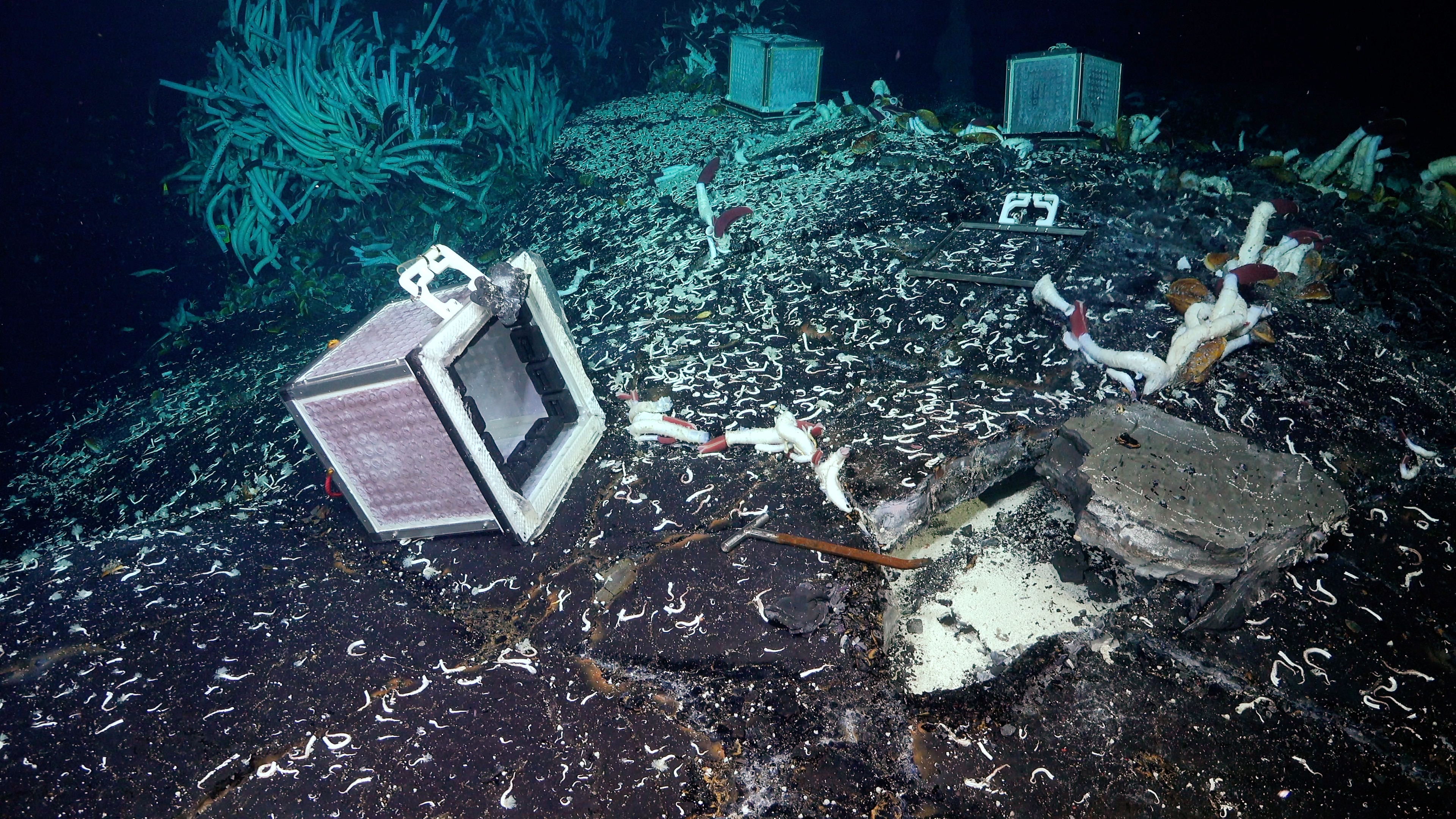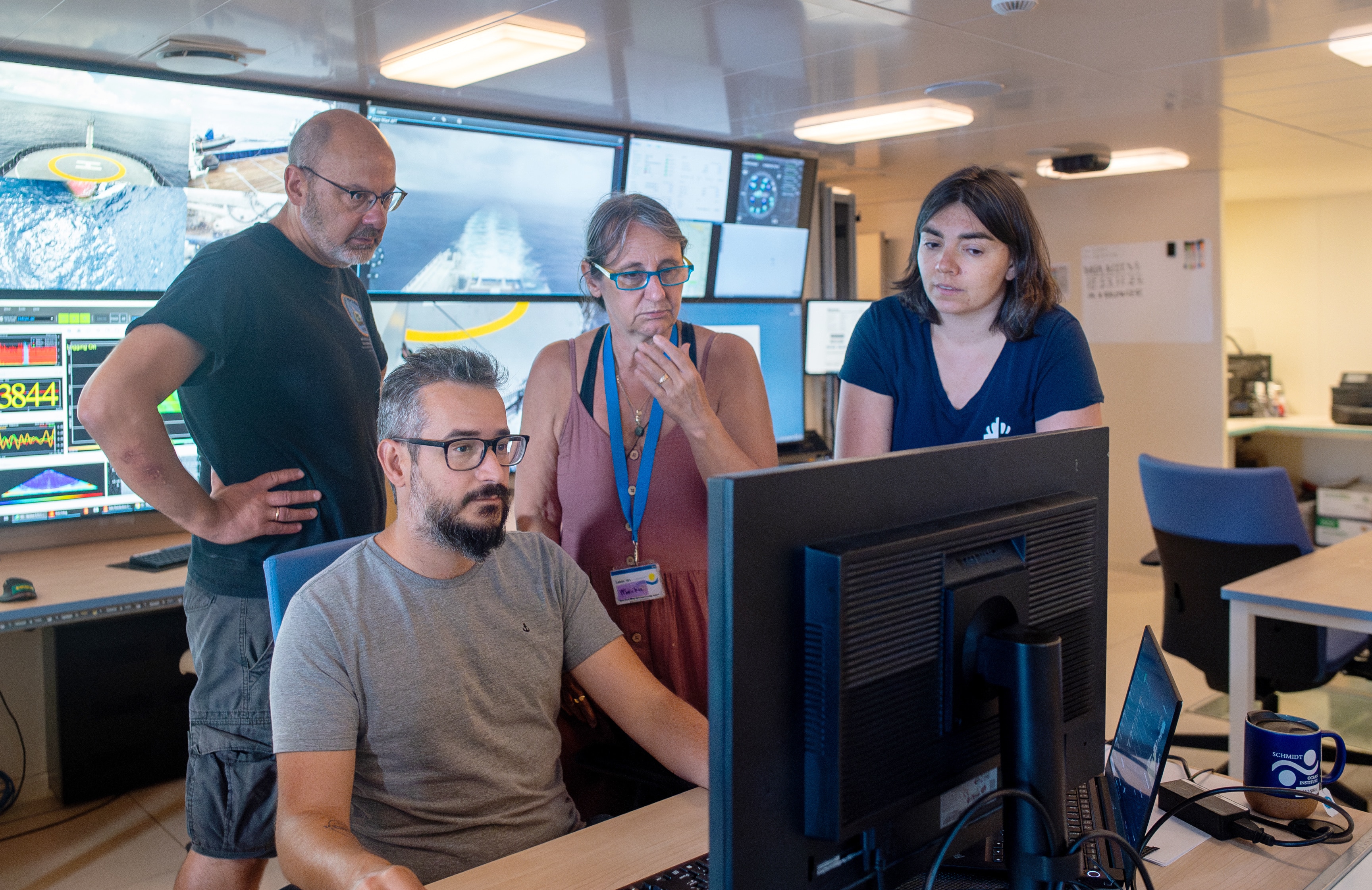Animals found living under the sea floor for the first time include worms and snails

A new study has found giant tubeworms live not just on the sea floor surface, but also underneath it.
In short:
A deep-sea submersible found worms and snails living in cavities below the sea floor — the first time animals have been discovered in such habitats.
The creatures may have been pushed into their subsurface home by swirling waters from nearby hydrothermal vents.
What's next?
Researchers are now checking for microscopic animals present under the sea floor's surface.
Beneath the ocean floor, under hydrothermal vents spewing hot water, a community of animals thrive.
That's according to a study published today in Nature Communications which reports, for the first time, animals living in cavities below the sea floor in the Pacific Ocean off the coast of Central and South America.
The team behind the find originally set out to undertake another experiment when they made the discovery, according to one of the researchers, Sabine Gollner from the Royal Netherlands Institute for Sea Research.
"We could not believe our eyes."
They saw giant tubeworms (Riftia pachyptila), each up to half a metre long, as well as snails and other types of worms dwelling in cavities formed by sheets of cooling lava 2,500 metres below sea level.
"We immediately knew that we made an important discovery," Dr Gollner said.
Life under a hydrothermal vent
Hydrothermal vents form at the boundary of two tectonic plates, deep in the ocean. Water is heated to scalding temperatures by magma below the surface and shoots out of fissures in the sea floor into the cold water above.
This mineral-filled hot water cools and deposits material around the vents, producing volcano-like tubes.
While the vents themselves can be extremely hot, the environment around a hydrothermal vent isn't quite as extreme — creatures living near the vents can expect temperatures of around 20 degrees Celsius.

A glimpse into the uncovered warm, fluid-filled sub-surface cavity which can be up to 40 centimetres high, at the deep-sea hydrothermal vents.
But, with no light making its way to these depths, the animals living there have developed amazing abilities to produce energy by other means.
One of the weirdest is the the giant tubeworm. These red and white creatures congregate in bunches, and while they can move about when they are larvae, they root themselves to one spot as adults.
They also have no stomach or digestive system, and require an infection from bacteria to produce their energy.
"The worm provides the bacteria with chemical energy … so it can live, [while] the bacteria provides food for the host," Dr Gollner said.
But while scientists have known that animals lived around the vents, the only life found under the sea floor were microbes — until now.
Hidden life revealed
As lava solidifies on the sea floor around hydrothermal vents, cavities can form between lava flows, similar to floors of a house.
Water can travel through cracks in the sea floor into the cavities, providing cold water for the hydrothermal cycle below.
As part of a research effort to study how tubeworms disperse in the ocean, Dr Gollner and her team used a remote-controlled submersible dubbed "SuBastian" to look for evidence of them in sub-sea-floor cavities.
To date, no tubeworm larvae have ever been found in ocean water samples. The researchers thought maybe the larvae dispersed via these sub-surface fluids, so they used SuBastian to crack open the top layer of a lava shelf and gain access to the cavity below.
The submersible took video and samples of what was below the sea floor.
"To our surprise, we found all kinds of hydrothermal vent animals," Dr Gollner said.
The team hypothesised that swirling water from the vent which percolated below the surface might push larvae of giant tubeworms and other creatures into cavities where they settle and take root.

Monika Bright, Sabine Gollner and colleagues discuss the dive operations.
Andrew Fisher, a hydrogeologist at the University of California, Santa Cruz who was not involved with the paper, says scientists have known for a while that large gaps can be present under the surface of the sea floor.
"Where there is space, life often finds a place to take hold," Professor Fisher said.
But he said finding evidence of such life is difficult because it lurks in small spaces and needs just the right conditions.
"That said, I don't think a lot of people have been looking systematically. There were other goals for a lot of vent expeditions, and lots of interesting life at the surface worthy of exploration."
For this study, the researchers could only look at the first layers under the sea floor, but with multiple layers of lava cavities beneath the surface, there may be animals even further down.
"The bigger critters may not be found too much deeper, but really we don't know," Professor Fisher said.
"Smaller, especially mobile creatures could go a lot deeper … as long as they have a source of nutrition."
What about other worlds?
While this is an exciting discovery for Earth, it may also have implications for other water worlds such as Jupiter's moon Europa.
Professor Fisher has undertaken research investigating hydrothermal vents on Europa and Saturn's moon Enceladus, and believes there might be similarities.
"When probes finally land on Europa and burn through the ice to explore the underlying ocean, I would not be surprised if they find hydrothermal flow, but [finding] life is a bigger challenge," he said.
"Earth's sea floor and ocean are connected to the global carbon cycle, which ultimately depends a lot on photosynthesis. Elemental cycling processes on Europa, Enceladus and other bodies are likely to be very different, and it is not clear if conditions would be right for life to develop.
"If they are, it could be very different from on Earth."
Back on Earth, the study's authors are now trying to classify data collected during the expedition, and hope to find microscopic animals that might have been missed on SuBastian's video recording.
"In the future, we would like to explore if this sub-sea-floor habitat also exists in other parts of the ocean, so for example at hydrothermal vents in the Atlantic Ocean," Dr Gollner said.
Science in your inbox
Get all the latest science stories from across the ABC.Your information is being handled in accordance with the ABC Privacy Collection Statement. By:https://www.abc.net.au/news/science/2024-10-16/first-animals-under-seafloor-hydrothermal-vents-tubeworms-snails/104468848(责任编辑:admin)
下一篇:Late own goal sees Socceroos battle to 1-1 draw against Japan in Saitama
 Socceroos rescue a point
Socceroos rescue a point  Wallabies thrash Wales 52
Wallabies thrash Wales 52 Jake Paul beats Mike Tyso
Jake Paul beats Mike Tyso Live updates: England vs
Live updates: England vs  US election 2024: Donald
US election 2024: Donald  US election live: Kamala
US election live: Kamala
- ·Brazil police formally accuse former pr
- ·Donald Trump's choice for US attor
- ·Japanese state sued in lawsuit seeking
- ·Jury finds MMA star Conor McGregor sexu
- ·Laken Riley's murder became a MAGA
- ·The celebrity look-alike craze is about
- ·Five remaining Bali Nine members could
- ·North Korea's latest weapon agains
- ·Brazil police formally accuse former pres
- ·Donald Trump's choice for US attorne
- ·Japanese state sued in lawsuit seeking to
- ·Jury finds MMA star Conor McGregor sexual
- ·Laken Riley's murder became a MAGA r
- ·The celebrity look-alike craze is about m
- ·Five remaining Bali Nine members could so
- ·North Korea's latest weapon against
- ·Hezbollah says Israel 'cannot impose
- ·Inside the rise of US oligarchs and how i
- ·One of Vietnam's high-profile politi
- ·Shanghai Walmart Attack: A Man Randomly S
- ·South Korean police officers jailed over
- ·Cambodia publicly shames maid deported af
- ·North Korea to use all forces including n
- ·Philippines condemns China attack of Viet
- ·US adds 2 more Chinese companies to Uyghu
- ·North Korean defector steals South Korean
- ·Malaysia deports Cambodian worker for cal
- ·Rebels battle for Myanmar junta’s weste

